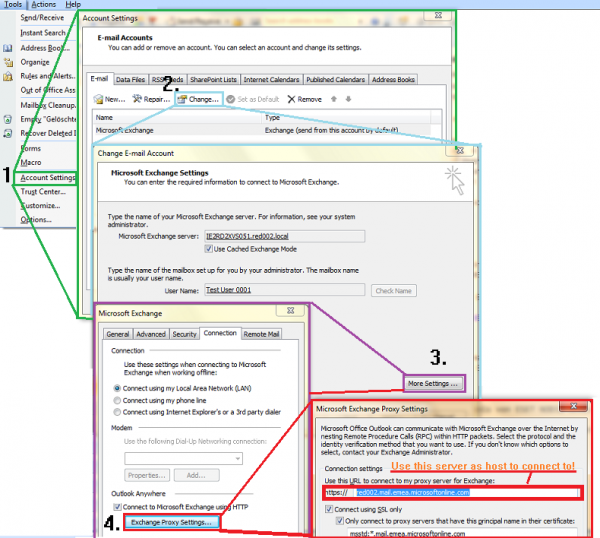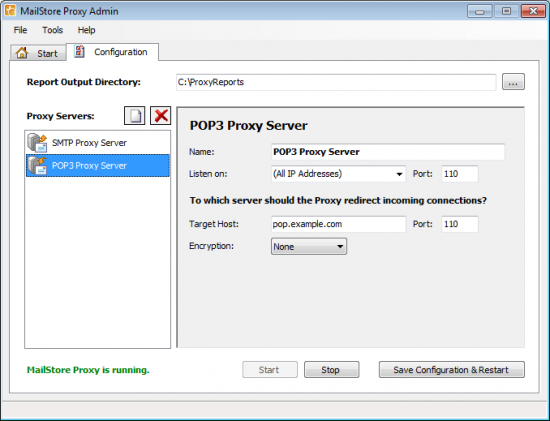Difference between revisions of "Archiving Emails Without Your Own Emailserver"
| [unchecked revision] | [unchecked revision] |
| Line 112: | Line 112: | ||
* Under ''Outgoing Mail Server (SMTP)'', select your current SMTP server and click on ''Edit'' | * Under ''Outgoing Mail Server (SMTP)'', select your current SMTP server and click on ''Edit'' | ||
| − | : [[File: | + | : [[File:Client_settings_smtp_de.png|600px|center]] |
* Change the SMTP server being used and enter the DNS name or the IP address of the MailStore Proxy | * Change the SMTP server being used and enter the DNS name or the IP address of the MailStore Proxy | ||
| Line 118: | Line 118: | ||
* To change the POP3 server, click on ''Server Settings'' | * To change the POP3 server, click on ''Server Settings'' | ||
| − | : [[File: | + | : [[File:Client_settings_pop3_de.png|600px|center]] |
* Change the POP3 server being used and enter the DNS name or the IP address of the MailStore Proxy | * Change the POP3 server being used and enter the DNS name or the IP address of the MailStore Proxy | ||
Revision as of 16:09, 21 February 2011
Please note: This article only addresses archiving methods in environments without an email server. It is assumed that you already have a MailStore Server installation or test installation and are familiar with the basic functionality of MailStore Server. Please refer to the Manual or the Quick Start Guide.
MailStore Server offers several methods for archiving emails from an email server; they are described in the following. If you are not sure which archiving method is best for your company, please refer to chapter Choosing the Right Archiving Strategy.
Creating and Synchronizing User Accounts
Why do I Need User Accounts in MailStore?
When emails are archived, they are always assigned to individual users. For each user, whose emails will be archived with MailStore, a user account has to be created in MailStore. In addition to manually setting up new users, MailStore Server provides several options for importing existing user data.
Active Directory Synchronization
Within an Active Directory Domain Service environment, MailStore's internal user database can be synchronized with the active directory of your company. A description of this feature is available in the article Active Directory Integration.
Generic LDAP Server Synchronization
MailStore Server offers support for generic LDAP servers, which is described in detail in the article Generic LDAP Integration.
Using a CSV File
In relation with IMAP batch archiving, using a CSV file constitutes another option for importing user data. Detailed information about this topic is available in the article Batch Archiving IMAP Mailboxes.
Archiving Individual Mailboxes
Archiving Local Email Programs
MailStore supports archiving emails from locally installed email applications such as Microsoft Outlook, Outlook Express or Mozilla Thunderbird. This archiving method is especially useful for archiving historic data and is generally executed only once for each user. The emails located in the users' local profiles are placed in the central MalStore archive on the server. A detailed description of how to set up this archiving method is available in the article Archiving Emails from Outlook, Thunderbird and Others.
Once the dispersed inventory data has been stored in the MailStore archive, we recommend setting up central archiving profiles directly on the MailStore server for regularly archiving the user mailboxes. These are described below.
IMAP / POP3
Archiving individual mailboxes on any email server can be done using the IMAP or POP3 protocols. Information about setting up the archiving process is available in the article Archiving Server Mailboxes.
Hosted Exchange
For archiving a Hosted Exchange mailbox, MailStore requires the access data for the email account made available by the provider. This includes user name (usually the email address), password as well as the (Exchange) server name.
Generally, the email application identifies the name of the Exchange server automatically using the autodiscover function (if supported by the service provider). This is why the server name is typically unknown to the user. To determine the required information, several options are available which are described below:
MailStore Exchange Autodiscover Tool
The free MailStore Exchange Autodiscover Tool provides the most convenient way for determining the Hosted Exchange server name. After downloading, extracting and starting the tool, it automatically detects the server name using the user name and password. Once retrieved, the data can be entered directly into the archiving profile.
Detecting Access Data Manually in Microsoft Outlook
The server can also be detected manually using the Exchange Proxy Settings in Microsoft Outlook. They can be found at Tools | Account Settings | Change| More Settings | Connection | Exchange Proxy Settings
The setup of the archiving process for a Hosted Exchange mailbox is the same as the setup for a single Exchange mailbox on a local Exchange server. Additional information is available at Archiving Individual Exchange Server Mailboxes.
Archiving Multiple Mailboxes in One Step
Batch Archiving of IMAP Mailboxes
Instructions for setting up batch archiving of IMAP mailboxes using a CSV file are available in the corresponding article.
Microsoft Hosted Exchange
If your Hosted Exchange service provider offers setting up a "service account", this account can be used to archive multiple mailboxes in MailStore Server centrally. A "service account" is a user account with extended access privileges to multiple Exchange mailboxes. Additional information as well as detailed instructions for setting the appropriate privileges is available in the articles | Exchange Server 2007 and | Exchange Server 2010
Archiving Incoming and Outgoing Emails Directly
To implement the archiving of all incoming and outgoing emails directly without using a local email server, several methods are available depending on which protocols are supported by your email service provider:
MailStore Proxy
If sending and receiving emails via POP3/SMTP, the free program MailStore Proxy can be used. Generally, the proxy server is placed between the local email client (e.g. Thunderbird, Outlook, etc.) and the email server of the service provider.
Setup of the MailStore Proxy
To setup the MailStore Proxy, please proceed as follows:
- Install the MailStore proxy server on a machine which is able to connect to the internet. This can but does not have to be the same machine on which MailStore Server is installed.
- Open the administration via MailStore Proxy Admin and set up a server for each, the incoming (POP3) and the outgoing (SMTP) connection. (Hint: If you retrieve your emails from different email servers, you can add additional proxy servers to the configuration.)
- Enter a meaningful name for the local SMTP server
- Under Incoming, choose the IP address from which the proxy server is to accept connections in the local network (default: All IP addresses)
- Enter the port used (default: port 25)
Please note:If there already is a program listening to port 25 installed on the machine on which the MailStore proxy server runs, an alternative port (e.g. port 26) has to be used for MailStore Proxy. Please keep in mind that this setting must be taken into account when setting up the email clients - Under Destination Server, enter the SMTP server address of your provider
- Enter the port used (default: port 25)
- If the connection to the destination server is to be encrypted, select the encryption type. Whether or not the connection to the destination server will be encrypted does in no way depend on the connection to MailStore Proxy being encrypted.
Please note: When using encryption type SSL, the connections are generally made via port 465, not port 25. If necessary, change the value of the field port under destination server accordingly. - If the SMTP server entered as destination server requires authentication, access data can be specified in the fields user name and password. This data is then used to connect to the destination server. Therefore, it is not necessary to keep the access data on the work stations.
Once the SMTP server connection is configured, open the POP3 Proxy Server tab to configure the POP3 server connection.
- Enter a meaningful name for the local POP3-Server
- Under Incoming select the IP address from which the proxy server is to accept connections in the local network. (Default: All IP addresses)
- Enter the port used (default: port 110)
Please note: If there already is a program installed on the machine on which the MailStore proxy server runs which is listening to port 110, an alternative port (e.g. port 111) must be used for MailStore Proxy. Please keep in mind that this setting must be taken into account when setting up the email clients. - Under destination server enter the POP3 server address of you provider
- Enter the port used (default: port 110)
- If the connection to the destination server is to be encrypted, select the encryption type. Whether or not the connection to the destination server will be encrypted does in no way depend on the connection to MailStore Proxy being encrypted.
Please note: When using encryption type SSL, the connections are generally made via port 995, not port 110. If necessary, change the value for the field port under destination server accordingly.
Once all necessary configurations are complete, the MailStore Proxy Server service must be restarted once. Afterwards, you may close the configuration program.
Setup of Email Clients
Next, configure your email clients for using MailStore Proxy (in the following described as using Mozilla Thunderbird and Outlook 2007).
Mozilla Thunderbird:
- In Mozilla Thunderbird, open the mailbox settings via Tools | Account Settings
- Under Outgoing Mail Server (SMTP), select your current SMTP server and click on Edit
- Change the SMTP server being used and enter the DNS name or the IP address of the MailStore Proxy
- Click on OK to save the changes
- To change the POP3 server, click on Server Settings
- Change the POP3 server being used and enter the DNS name or the IP address of the MailStore Proxy
- Save the new settings
Send a test email to verify the new settings. If they are correct, the email will be sent to the mailbox of the recipient. In the output directory, you will also find a copy of the email message in *.eml format as well as a report file in *.mpr format.
Microsoft Outlook
- Open the mailbox settings
Outlook 2007: In the Tools menu, click on Account Settings
Outlook 2010: On the ribbon bar, click on File and under the menu item Information on Account Settings | Account Settings - Select the appropriate account and click on Change
- Change the SMTP server as well as the POP3 server being used and enter the DNS name or the IP address of the MailStore Proxy
- Save the changes by clicking on Next | Finish
Send a test email to verify the new settings. If all settings are correct, the email will be sent to the mailbox of the recipient. In the output directory, you will also find a copy of the email message in *.eml format as well as a report file in *.mpr format.
In environments with branch- or home offices, please note: Please keep in mind that all email clients have to be set up for using the MailStore proxy server. Because of this, the email clients in branch- or home offices have to be routed through the main office for sending or receiving emails. This can be done by using a VPN connection, for example.
IMAP-Sammelpostfach
If your email service provider supports setting up and using an IMAP or POP3 multidrop mailbox, it can also be used to archive all incoming and outgoing emails in MailStore (as an alternative to using the MailStore proxy server). Setup procedures are described in the article Archiving IMAP and POP3 Multidrop Mailboxes.




